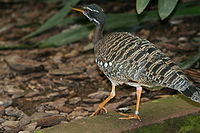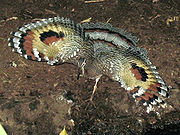
Sunbittern
Encyclopedia
The Sunbittern, Eurypyga helias is a bittern
-like bird
of tropical regions of the Americas
, and the sole member of the family
Eurypygidae (sometimes spelled Eurypigidae) and genus
Eurypyga.
 The bird has a generally subdued coloration, with fine linear patterns of black, grey and brown. Its remiges however have vividly-colored middle webs, which with wings fully spread show bright eyespots in red, yellow, and black. These are shown to other sunbitterns in courtship and threat displays, or used to startle potential predators. Like some other birds, the Sunbittern has powder down.
The bird has a generally subdued coloration, with fine linear patterns of black, grey and brown. Its remiges however have vividly-colored middle webs, which with wings fully spread show bright eyespots in red, yellow, and black. These are shown to other sunbitterns in courtship and threat displays, or used to startle potential predators. Like some other birds, the Sunbittern has powder down.
They build open nests in trees, and lay two eggs with blotched markings. The young are precocial
, but remain in the nest for several weeks after hatching.
extends from Guatemala
to Brazil
. The species may also be present in southern Mexico
: it has been traditionally reported from the Atlantic slope of Chiapas
, but no specimens are known and there have been no recent records.
The Sunbittern is normally found foraging on the ground and scratching for insects.
 The Sunbittern is usually placed in the Gruiformes, but this was always considered preliminary. Altogether, the bird is most similar to another enigmatic bird that was provisionally placed in the Gruiformes, the Kagu
The Sunbittern is usually placed in the Gruiformes, but this was always considered preliminary. Altogether, the bird is most similar to another enigmatic bird that was provisionally placed in the Gruiformes, the Kagu
(Rhynochetos jubatus). Molecular studies seem to confirm that the Kagu and Sunbittern are each other's closest living relatives. They are probably not Gruiformes (though the proposed Metaves are just as weakly supported). Altogether, the two species seem to form a minor Gondwana
n lineage which could also include the extinct adzebill
s and/or the mesite
s, and is of unclear relation to the Gruiformes proper. Notably, the Kagu and mesites also have powder down.
A DNA study by Hackett et al. (2008) concluded strongly, as well as Fain & Houde (2004) and other researchers, that the Sunbittern and the Kagu form a clade
, but puts these two as a sister group of the swifts, nightjars and hummingbirds.
Bittern
Bitterns are a classification of birds in the heron family, Ardeidae, a family of wading birds. Species named bitterns tend to be the shorter-necked, often more secretive members of this family...
-like bird
Bird
Birds are feathered, winged, bipedal, endothermic , egg-laying, vertebrate animals. Around 10,000 living species and 188 families makes them the most speciose class of tetrapod vertebrates. They inhabit ecosystems across the globe, from the Arctic to the Antarctic. Extant birds range in size from...
of tropical regions of the Americas
Americas
The Americas, or America , are lands in the Western hemisphere, also known as the New World. In English, the plural form the Americas is often used to refer to the landmasses of North America and South America with their associated islands and regions, while the singular form America is primarily...
, and the sole member of the family
Family (biology)
In biological classification, family is* a taxonomic rank. Other well-known ranks are life, domain, kingdom, phylum, class, order, genus, and species, with family fitting between order and genus. As for the other well-known ranks, there is the option of an immediately lower rank, indicated by the...
Eurypygidae (sometimes spelled Eurypigidae) and genus
Genus
In biology, a genus is a low-level taxonomic rank used in the biological classification of living and fossil organisms, which is an example of definition by genus and differentia...
Eurypyga.
Description and reproduction

They build open nests in trees, and lay two eggs with blotched markings. The young are precocial
Precocial
In biology, the term precocial refers to species in which the young are relatively mature and mobile from the moment of birth or hatching. The opposite developmental strategy is called "altricial," where the young are born or hatched helpless. Extremely precocial species may be called...
, but remain in the nest for several weeks after hatching.
Distribution and habitat
The Sunbittern's rangeRange (biology)
In biology, the range or distribution of a species is the geographical area within which that species can be found. Within that range, dispersion is variation in local density.The term is often qualified:...
extends from Guatemala
Guatemala
Guatemala is a country in Central America bordered by Mexico to the north and west, the Pacific Ocean to the southwest, Belize to the northeast, the Caribbean to the east, and Honduras and El Salvador to the southeast...
to Brazil
Brazil
Brazil , officially the Federative Republic of Brazil , is the largest country in South America. It is the world's fifth largest country, both by geographical area and by population with over 192 million people...
. The species may also be present in southern Mexico
Mexico
The United Mexican States , commonly known as Mexico , is a federal constitutional republic in North America. It is bordered on the north by the United States; on the south and west by the Pacific Ocean; on the southeast by Guatemala, Belize, and the Caribbean Sea; and on the east by the Gulf of...
: it has been traditionally reported from the Atlantic slope of Chiapas
Chiapas
Chiapas officially Estado Libre y Soberano de Chiapas is one of the 31 states that, with the Federal District, comprise the 32 Federal Entities of Mexico. It is divided in 118 municipalities and its capital city is Tuxtla Gutierrez. Other important cites in Chiapas include San Cristóbal de las...
, but no specimens are known and there have been no recent records.
The Sunbittern is normally found foraging on the ground and scratching for insects.
Taxonomy

Kagu
The Kagu or Cagou is a crested, long-legged, and bluish-grey bird endemic to the dense mountain forests of New Caledonia. It is the only surviving member of the genus Rhynochetos and the family Rhynochetidae, although a second species has been described from the fossil record...
(Rhynochetos jubatus). Molecular studies seem to confirm that the Kagu and Sunbittern are each other's closest living relatives. They are probably not Gruiformes (though the proposed Metaves are just as weakly supported). Altogether, the two species seem to form a minor Gondwana
Gondwana
In paleogeography, Gondwana , originally Gondwanaland, was the southernmost of two supercontinents that later became parts of the Pangaea supercontinent. It existed from approximately 510 to 180 million years ago . Gondwana is believed to have sutured between ca. 570 and 510 Mya,...
n lineage which could also include the extinct adzebill
Adzebill
The adzebills, genus Aptornis, were two closely related bird species, the North Island Adzebill, Aptornis otidiformis, and the South Island Adzebill, Aptornis defossor, of the extinct family Aptornithidae. The family was endemic to New Zealand.They have been placed in the Gruiformes but this is not...
s and/or the mesite
Mesite
The mesites are a family of birds of uncertain affinities. They are smallish, near flightless birds endemic to Madagascar. Generally brownish with paler undersides, they are of somewhat pheasant-like appearance and were initially placed with the Galliformes...
s, and is of unclear relation to the Gruiformes proper. Notably, the Kagu and mesites also have powder down.
A DNA study by Hackett et al. (2008) concluded strongly, as well as Fain & Houde (2004) and other researchers, that the Sunbittern and the Kagu form a clade
Clade
A clade is a group consisting of a species and all its descendants. In the terms of biological systematics, a clade is a single "branch" on the "tree of life". The idea that such a "natural group" of organisms should be grouped together and given a taxonomic name is central to biological...
, but puts these two as a sister group of the swifts, nightjars and hummingbirds.
External links
- BirdLife Species Factsheet
- Sunbittern videos, photos & sounds on the Internet Bird Collection

